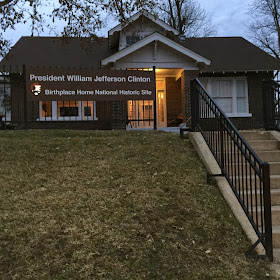Love him or hate him, you have to be intrigued by Bill Clinton, In America, we love our rags to riches stories, and Bill's is a pretty good one.
Bill Clinton was born in Hope, Arkansas, a small town 112 miles from Little Rock. His father was killed in an accident three months before he was born, so Bill lived in this cute little frame house with his maternal grandparents for the first four years of his life while his mother studied nursing in New Orleans.
When his mother remarried, he moved to another house in Hope before eventually moving to Hot Springs, Arkansas, where he graduated from high school. Clinton went to college at Georgetown University on a scholarship--I'm guessing that was not something that happened often to Hot Springs High School graduates. Upon graduation he was awarded a Rhodes Scholarship to Oxford University, following which got his JD from Yale University. After graduation he married Hilary, and a few years later he returned to Arkansas, where he was elected governor in 1978 at age 32.
Impressive stuff for a little boy from Hope.
Clinton notes that when it came time to build his library, members of his graduating class at Georgetown offered him $30 million if he would build it in Washington, D.C. He told them he couldn't do that. "I have to put it in Arkansas, and I have to put in in Little Rock, because I would never have become president without the people of Arkansas," he said.
The William J. Clinton Presidential Center and Park is a complex that includes the University of Arkansas Clinton School of Public Service, housed in what was once a train depot, followed by a newspaper office, and then--believe it or not--a Spaghetti Factory restaurant. Perfect for a president known for his love of carbs.
In contrast, the building next door, the Clinton Presidential Library, is a somewhat sterile modernist steel and glass building cantilevered over the Arkansas River. (There are those who criticize it for looking like "a trailer on stilts.")


































